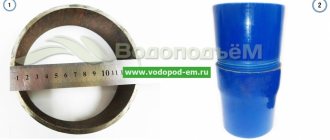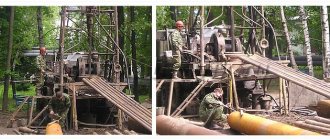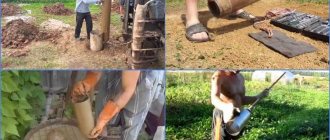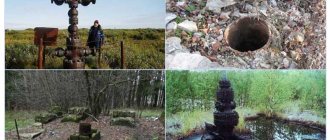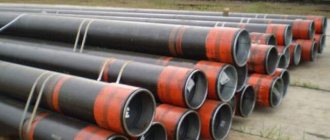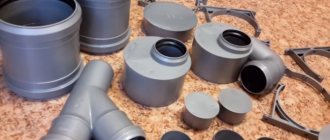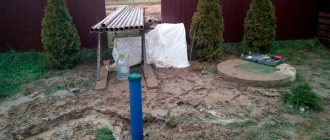Drilling wells to obtain drinking water is quite often an integral process when arranging a country house. But the structure has its own maximum service life, so after a certain time it fails. There is a need to liquidate the object. This procedure is called well plugging.
Process Features
Well plugging during abandonment is a set of works to fill cracks in the soil using cement mortar or other binder. For these purposes, it is advisable to use a material that can harden quickly. Otherwise, the required result will not be achieved.
Grouting and abandonment of artesian wells does not allow the following impurities to seep into the well (water intake structure):
- Petroleum components.
- Solid particles from the soil.
- Ground liquid.
Cementation allows you to seal the space that forms near the casing and the walls of the penetration. This process requires the injection of some kind of binder around the casing or into the bore.
Grouting works are divided into the following types:
- Liquidation. This procedure is performed if the old well is dangerous when used or threatens to collapse. In this case, it is removed by cementing. Liquidation plugging can significantly reduce the likelihood of groundwater contamination with harmful substances.
- Protective. This method avoids the penetration of groundwater into the spring. Undershoe cementing prevents leakage of water, which is dangerous to human health.
Before plugging, it is mandatory to examine the well and take water samples inside the structure. If there are indications for carrying out work, the preparation of documents begins (a report is drawn up, a project is developed).
After the documentation is approved, the walls of the structure begin to be plugged. This can only be done by experts from special services who have sufficient experience and appropriate equipment.
Why are water intake sources eliminated?
Elimination or conservation of artesian wells is necessary to prevent harmful and toxic substances from entering water horizons during man-made accidents or natural disasters. It is possible to sabotage the casing and contaminate the water with bacteria.
Uncontrolled consumption can cause irreparable harm to natural resources, including depletion of aquifers.
Leaving abandoned springs is prohibited.
Canning is the decommissioning of a water supply source with the possibility of restoring functionality.
After liquidation, it is impossible to restore the operation of the mine.
There are 4 categories of objects subject to plugging:
1. Structures that have fulfilled their function, for example:
- Water is needed for the construction period, before connecting to the water supply;
- The amount of liquid does not ensure the economic feasibility of production or has run out;
- The enterprise, the house, the dacha were closed, destroyed, destroyed.
2. Impossibility of production for geological reasons:
- Lack of water in the required horizon;
- Receiving unusable liquid;
- Inability to complete drilling due to the composition or structure of geological layers.
3. Destruction (for various reasons) of the structure during construction, use, accident. Unsuitable for further operation due to strength characteristics - corrosion of casing pipes and other elements.
4. Structures preserved for more than 10 years. Objects located in sanitary protection or water protection zones or places that again fall within the boundaries of the zones due to changed geological conditions.
Temporary suspension of the operation of an existing facility without conservation is possible for a period of up to six months.
The owner’s obligation to eliminate unused, abandoned and emergency water sources is established by Government Decree No. 94 of 02/11/2016.
Benefits of performing the procedure
Cementing hydraulic structures has many advantages. This allows not only to improve water quality, but also to extend the service life of the structure. With tamponage you can achieve:
- Additional waterproofing of the structure.
- Reducing the likely risk of deformation during installation of additional fasteners on the column.
- Increased protection against depressurization of structural joints.
- Complete sealing of water resources that are extracted from the well.
The liquidation type of work also has its advantages. With the help of such grouting, it is possible to protect groundwater from pollution and secure emergency wells. Wells that have become unusable are dangerous because they can lead to injury to a person or even an accident.
The procedure is quite expensive, but the benefits completely justify it. Especially when it comes to a well that is used by several houses.
The cost of liquidation plugging of a well
Well plugging has its own prices. The cost of well abandonment work depends on the diameter of the production casing and the depth of the object.
| Diameter (mm) | Depth (m) | Price per meter |
| 168 | up to 150 | 3,000 rub. |
| 168 | more than 150 | 3,100 rub. |
| 219 | up to 150 | 4,500 rub. |
| 219 | more than 150 | 4,600 rub. |
| 325 | up to 150 | 6,000 rub. |
| 325 | more than 150 | 6,100 rub. |
| large diameters | — | negotiable |
In terms of labor intensity, eliminating a water well can be no less difficult than drilling. One of the reasons is the lack of documentation about the well design and geological section of the area.
Protection against high water
Liquidation plugging is not used for Abyssinian wells and sand wells. This is due to the fact that these structures are not deep enough to risk possible contamination of artesian waters.
Such structures are plugged directly during construction. The main goal of the entire process is to protect the aquifer from the ingress of perched water. To do this, you need to plug the space near the pipe.
Several methods are used:
- Using concrete mortar. There are simpler methods of insulation, so concrete is used quite rarely. Crushed stone is poured around the pipe, and then the space is filled with cement-sand mortar.
- Application of bedding. Sometimes you can use the simplest waterproofing. This method implies that a film is spread around the well and then covered with earth.
- Arrangement of the clay layer. First, a layer of crushed stone is poured into the space around the pipe, and the upper few meters are filled with clay. This is a fairly effective and economical method of sealing, as a dense waterproof layer is formed.
These methods allow you to quickly plug Abyssinian and sandy wells. The work does not require the involvement of specialists.
When killing a well is a necessary procedure
If a fountain gushes from a pipe, it must be plugged, and the pressure of the downhole plug must exceed the water pressure.
When water gushes from a source higher than 5 meters, a special liquid of very high density must be pumped into the siege column to such an extent that its pressure exceeds the pressure of water from the bowels. All these cases are emergencies and require urgent intervention and elimination. The jamming procedure will quickly eliminate the problem, eliminate unwanted consequences and ensure that the situation does not recur. When the repair is completed, the high-density liquid will be pumped back, the installation will be flushed and can be used further. In some cases, it is necessary to shut down the system forever, which means that it cannot be used further.
Necessity of application
Cementation is a specific technological process that is necessary to cover and separate the aquifer with a special pad. The space between the earthen shaft and the water shaft is cemented. Concrete, clay and molten plastic can be used for this.
The purpose of the technological process is to prevent the possible entry of chemical and biological contaminants into the consumed and underlying water. The procedure is performed in the following cases:
- It is necessary to increase the waterproofing of the structure, as the water quality has decreased.
- The water point will no longer be used.
- Defects have been discovered in the well design or geological problems have been identified.
- Productivity has decreased, but there is no way to restore the structure.
- It is necessary to eliminate the risk of water contamination if the drilling or use of the well was carried out improperly.
- It is necessary to prevent mixing of different water horizons.
- The structure was severely deformed or collapsed.
In addition to all of the above, the cementing procedure is performed when searching for new aquifers. If drilling is unsuccessful, it is necessary to plug the well.
Reasons for plugging a well
The reason for the liquidation of a well can be natural phenomena, for example, the collapse of rocks around the casing pipes. If the wellhead was poorly isolated during installation, problems will arise during the operation of the well. Polluted or contaminated water is also a reason to close the source and dig a well in a new place.
Artesian wells are liquidated:
- in case of a sharp and significant decrease in water supply;
- if the well does not meet sanitary standards;
- when the source is not economically viable;
- when the quality of the system deteriorates and cannot be restored;
- if dirt, debris and other contaminants get into the water;
- if it is necessary to build a new well in another location;
- due to geological exploration.
Important!
It is better to contact experienced liquidators who have undergone training. They are required to give a guarantee after the work done.
Types of binding solutions
Tamponation is a rather labor-intensive process that requires proper preparation. Therefore, you first need to perform preliminary calculations . They take into account the following:
- The distance between the ground and the hydraulic structure.
- The depth of the aquifer.
- Amount and composition of soil.
- Possible violations during the construction and operation of the structure.
- Presence of impurities in water.
Binders are selected based on the composition of the soil and its type. This is the most important factor. The following solutions are used for work:
- Cement mortar with the addition of fibrous components, asbestos or paper. This substance is used for wells that are located on floating or porous soils.
- A mixture of Portland cement and sand. This solution is used to cement structures built in clay and loam.
- Liquid plastic and foam solutions. They are used for structures located in hard soils. With their help, you can achieve maximum waterproofing of structures.
I always make solutions for grouting work liquid to increase convenience and reduce the load on pumping equipment. Pumping is carried out through the inlet pipe.
Solutions used and method features
Cementation of a water well is carried out using a special composition of solutions and special equipment. This allows work to be carried out quickly and safely. Naturally, before carrying out the work itself, the necessary calculations should be carried out and the appropriate documentation drawn up. Thanks to these actions it is possible to calculate:
- Required volume of mixture.
- Purchase the required amount of cement.
- Solution supply methods.
When a project is drawn up to carry out the work described, the following is taken as a basis:
- depth of the water intake point;
- type of penetration;
- the length of the space from the well to the casing.
If the water intake shaft has defects or drilling irregularities, these are also taken into account.
In addition to the depths of artesian wells, the characteristics and structure of the soil horizon are included in the project. This helps to understand how the solution should be made in order to obtain the required level of strength. The composition of the soil and other information regarding the old well can be taken from the existing passport.
Thanks to such subtleties, you can perform all the work efficiently, spending a minimum amount of money and effort.
For each plugging it is recommended to prepare a different type of solution necessary for certain soils and aquifers. The following solutions are most often used for the described work:
- "Foaming." A feature of such compositions is the ability to expand during solidification due to the addition of special components. This contributes to better sealing of the liquid inside the column.
- "With fillers." Compositions with fillers are effective for plugging wells drilled inside porous rocks. The introduction of fillers (paper, asbestos, fibers) into the solution helps reduce the consumption of conventional cement-sand mixture.
- "Traditional". It is prepared on the basis of a traditional mixture of sand and cement. This solution is used for plugging wells inside clayey rocks. It is advisable to prepare this mixture on the basis of “Portland cement”, which is characterized by its mobility and rapid hardening. In addition, such a composition firmly adheres to the mineral layer and is easily pumped.
Often, the solution for plugging wells is enriched with gravel or sand, but the resulting consistency is always left liquid.
The working solution is prepared within a few minutes, especially if you have the necessary equipment for this. This saves people's working time and makes it easier to pump the composition with pumps. The finished mixture is fed through a filling pipe to a three-meter height. In order to disinfect its composition, bleach can be added inside.
Preparatory work
Before performing tamponage, a preparatory stage is mandatory. If there are pumps or other equipment inside the water well, it must be turned off and raised to the surface. It is advisable that the execution of all work be supervised directly by the owner of the well, since it is he who will be responsible for all possible negative consequences.
Also, before using cement-sand mortar, you must obtain approval from the sanitary and epidemiological station. Otherwise, a large fine may follow.
After completion of the plugging, the well owner will have to do water tests to obtain a conclusion about its safety. It will also be necessary to take all supporting documents to the sanitary and epidemiological station and utility services.
Video: preserving a well for the winter
Over the course of their service life, water wells often lose their technical characteristics and become unusable. During this period, legal abandonment of wells most often occurs.
The reasons for the cessation of activity of the water intake canal may be:
- Leakage and construction of the internal pipe of the source and the possibility of contamination of water by chemical injections into the liquid (to determine the quality of water, a sample is taken from the source);
- A geological study of the soil was not carried out according to the rules;
- Deviations from technology at the time of well installation;
- The location of the water intake canal is in an area prohibited by regulatory authorities.
It is worth noting that the decision to abandon wells can be made at different stages of its existence:
- During the drilling of the canal (if a water sample confirmed its unsuitability for use or technical problems occurred with the horizon equipment);
- During the construction of the internal channel of the well;
- Or during its service life.
- Well abandonment is a measure aimed at complete and irreversible cessation of the activity of a water intake canal using plugging using a special technology. The raw material for the formation of a durable tampon is a strong concrete solution that is indestructible over time.
- Temporary conservation of wells is an event that allows you to stop drawing water from the underground horizon for a certain period. Used to retrofit the internal channel flask or improve the technical characteristics of the well. Thanks to conservation using special technology, the use of the source can be temporarily stopped and returned to it after a certain period of time.
The decision to plug a well can be made both in relation to a working canal, and a temporarily mothballed one, but no longer allowing the use of underground horizon resources.
Tamponing technology
Grouting begins with preparing the project and obtaining the results of the necessary analyzes. After collecting the package of documents, you can purchase materials and get to work.
Tamponation is performed using several methods:
- Reverse cementation. A plug is installed deep in the well to separate the zones. The solution is fed into the column, where due to pressure it is removed beyond its limits.
- Supply of cement-sand mixture to fill cavities between the shaft and the structure. The solution fills everything on its own. The quality of the filling in this case is low, but this method is simple and affordable.
- For deepwater wells, work is divided into stages. Filling occurs in several layers.
- Application of clay cylinders. They are mounted directly into the penetration. Before use, the clay is soaked to create a thick mixture. Using a high power pump, high pressure is created, causing the clay cylinders to be pressed.
The important point is that grouting must be carried out to the lower level of the aquifer. This process is carried out to protect the consumed water from contamination. Quite often you can do everything yourself. But it would be better to entrust liquidation tamponing to specialists who have sufficient experience and the necessary equipment.
How to organize tamponing correctly
The operation of water use facilities is regulated by law:
- Law of the Russian Federation “On Subsoil”;
- Water Code of the Russian Federation;
- Decree of the Government of the Russian Federation No. 94 of February 11, 2016
There are fines for lack of a license and failure to comply with regulations:
- For individuals – 3-5 thousand rubles;
- For officials - from 30 to 50 thousand rubles;
- Organizations will pay from 800,000 to 1 million rubles.
The correct decommissioning of used structures is regulated by the manual RD 08-492-02, which contains instructions on how to properly seal the shaft.
In general terms, the instructions establish the mandatory compliance with requirements by all liquidation participants: owners, design and operating (liquidating) organizations.
Important! Personnel involved in the process are trained and confirm their knowledge of work methods and standards. It is prohibited to hire workers who have not undergone training.
The responsibility for organizing the work and paying for it lies with the owner of the water supply source.
Liquidation is carried out by order of controlling organizations or the process is initiated by the owner.
Conservation and liquidation is carried out by a licensed organization on the basis of concluded agreements:
- Contracts for the production of the project.
- Work contracts.
Required sections of the project:
- Geological and hydrological conditions at the site;
- Engineering-geological substantiation of probable adverse consequences - rock falls, ground failures, flooding of the territory during depressurization.
- Explanatory note justifying the need for the event;
- Technology and solutions for work execution;
- Procedures for carrying out work and measures to ensure industrial safety;
- Security measures to protect the environment;
- Estimate, including consumption of fuels and lubricants, calculation of the equipment involved, wages and other sections.
The approval of the project is carried out by the bodies of Rosprirodnadzor; until its approval, activities at the site are prohibited. Violation is punishable by a fine.
Attention! It is not allowed to violate the deadlines established by the project. Failure to comply with the requirement will result in a fine.
Based on design decisions, a specially created commission develops a plan for isolation and liquidation work.
Only after developing a project and drawing up an estimate does it become clear how much tamponation will cost.
Important! Completion of work is documented by an act, which is registered and kept by the owner. Copies of all documents are sent to the Rostekhnadzor and Rospotrebnadzor bodies for recording and storage.
Calculations required when cementing wells
After a complete identification of the drilled well has been carried out, the corresponding calculations begin, during which the following data necessary for cementing are obtained:
| № | Helpful information |
| 1 | the optimal composition of the cement mixture is determined |
| 2 | the required amount of consumables for preparing the solution is calculated |
| 3 | a verification calculation is carried out, giving the required amount of buffer liquid |
Calculations can be carried out both manually and using automatic means, using the necessary software.
For successful calculation, the following input data is required:
- diameter of the cemented well;
- required density of cement mortar;
- seal ring height;
- volume of the glass and so on.
After the automated calculation, the program produces the result in the form of a table, which includes all the necessary data. If you replace some of the original values in such a table, the recalculation is carried out automatically and the result will be different.
Currently, manual calculations are rarely used, but this technique still has the right to exist. Incoming data during manual calculation is no different from automated calculation.
Using the example of single-stage cementing technology, we will consider the sequence of calculations. It looks like this:
- begin the calculation by calculating the height of the buffer liquid column, taking into account a predetermined anomaly coefficient;
- then the height of the cementing solution column located outside the production casing is calculated;
- the required volume of such a solution is determined;
- the weight of the dry cement part is calculated;
- the required amount of water or other diluting liquid is calculated;
- The maximum pressure value that will be on the thrust ring is calculated.
At the final stage of the calculation, the required supply of cement by the appropriate units, as well as the number of cementing devices, is determined. Also during the calculation process, the number of cement mixers required to provide the required volume of cementing solution is determined.
In conclusion, let's summarize.
Of course, the quality of the solution to this difficult engineering problem is directly dependent on compliance with the correct sequence and all the rules for carrying out the necessary technological operations, as well as on the correctness of the calculations and the qualifications of the personnel. Workers and engineers directly carrying out cementing must fully comply with all the requirements for carrying out this work.
In addition, the quality of the materials used to prepare the cement mixture, as well as the serviceability and efficiency of the equipment used, plays an important role in this process. Compliance with all of the above requirements allows this work to be carried out efficiently, which makes it possible to significantly extend the service life of deep well structures.
Bibliography:
- Oil and Petroleum Products - Wikipedia
- Khaustov, A.P. Environmental protection during oil production / Khaustov, A.P., Redina, M.M. Publishing house: “Delo”, 2006. 552 p.
- Alekperov, V.Yu. Oil of Russia: past, present and future / Alekperov V.Yu. M.: Creative Economy, 2011. – 432 p.
- Publisher: “Oil and Gas”, 2006. 352 p. Surgutneftegaz.
- Economides, M. The color of oil. The world's largest business: history, money and politics / Economides M., Olini R. Publishing house: “Olympus-Business”, 2004. 256 p.
Advantages and disadvantages
The technological process is widespread because it has a fairly extensive list of advantages:
- Improving the sealing of connecting seams of concrete casing rings and strengthening the structure as a whole.
- Implementation of additional waterproofing.
- Preventing the penetration of runoff and perched water into the artesian well.
Among the disadvantages, it is worth noting the financial, physical and time costs. Experts recommend that liquidation tamponing be trusted by professionals, since the procedure requires the use of special technology and equipment. Protective plugging can be carried out independently.
Stages of work to eliminate sources
If there is a need to plug a source, it is important to understand that this should be done by specialized organizations. Firstly, they have the appropriate equipment, and secondly, they have the appropriate experience.
Cementing scheme
Elimination stages are divided into two groups:
- Preparation.
- Conservation.
They include:
- general area analysis;
- determination of well characteristics - depth, flow rate, arrangement diagram;
- analysis of its condition and, if necessary, search for the causes of source contamination;
- the list of necessary works and the technology for their implementation are determined;
- design documentation is prepared and agreed upon;
- a pit measuring 1.5 by 1.5 meters is dug near the casing pipe, the depth is 1-2 meters;
- the upper part of the column is cut off;
- At this point, the preparatory work ends and the liquidation process begins;
- Using special equipment, the pipe is well cleaned of natural contaminants, and then disinfected;
- a cushion of crushed stone is made at the bottom, its height is equal to the filter zone;
- Cement mortar is poured into the pipe.
After the concrete has hardened, a cushion of crushed stone is made in the pit. In this case, a small distance is left to the level of the main soil - 30-50 cm. It is covered with earth or other material. At this point, the plugging of the artesian well ends. There remains only the last documentary stage - deregistration of the source and preparation of the relevant documentation.
Conservation of water wells ↑
A water intake structure can be temporarily mothballed both at the construction stage and during use, which is due to various circumstances.
Reasons and features of conservation ↑
There are several reasons for mothballing a well:
- inability to continue drilling operations due to force majeure;
- problems encountered with financing the development of the facility;
- temporary lack of need to operate a water supply source;
- discrepancy between actual technical specifications and design ones (until the reasons are clarified);
- closing the gushing source until atmospheric and interlayer pressure equalizes.
Stages of work ↑
- The equipment that interferes with tamponing is removed.
- Tubing pipes are lowered into the shaft to flush the structure and clean the perforation interval.
- The tightness of the column is checked, as well as the absence of annular circulation.
- The barrel is filled with a neutral composition to prevent pipe corrosion and maintain the productivity of the horizon.
- The upper part of the structure is filled with non-freezing liquid.
- The piping of the mouth, the installation of cement bridges and other technological aspects are established by the design documentation.
Preservation of a well is a sure way to preserve a source of water supply during a long break in operation
Grounds for liquidation of water intake
If the well fits one of the categories listed above, then it should be abandoned, because there is a possibility that the aquifers will be contaminated, and they can be used by other water intakes. After reading the “Law on Subsoil”, you can find out that the user must ensure the elimination of the source and the safety of the water intake.
When is tamponage done?
This procedure can be carried out for wells in the following cases:
- isolation of individual aquifers is required - this is done when the water in individual horizons is of low quality;
- it is no longer planned to use the well;
- the productivity of the source has fallen, and restoration is not possible;
- its service life has expired;
- the source has become unusable due to technical reasons, for example, severe corrosion of the casing columns has occurred or the aquifers are heavily polluted.
In addition, liquidation plugging of wells is used for exploration drilling, the purpose of which is to study aquifers. Also, cementing allows you to strengthen the column and significantly extend its service life. An additional advantage is protection against possible deformation and penetration of water.
